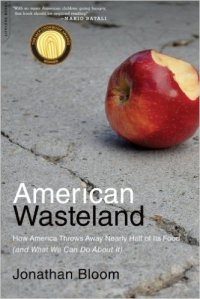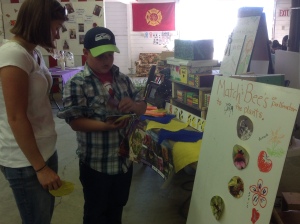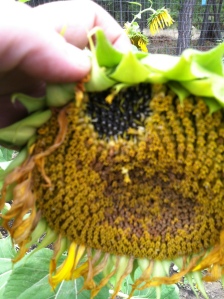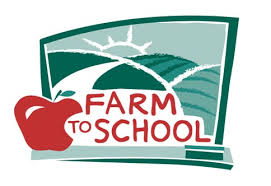replay of episode 86: Garden and Agriculture Educator Extraordinaire Changing how our schools eat one cafeteria at a time | Patti Armbrister | Hinsdale, MT

This episode was originally published on October 8, 2015.
Patti Armbrister is an educator and policy changer who looks for positive solutions to producing and eating locally grown food in our schools. She teaches agricultural education in a rural school but is making change that affects our farmers, students, and families as she connects locally grown healthy food with nutrition and education. After building a passive solar green house and root cellar in the Hinsdale Outdoor Classroom, this phenomenal speaker and farmer who is also a self-proclaimed “beef geek” shares her story of getting recognizable meat and real potatoes into the school cafeteria. Be inspired to make change in your local school district by learning about the wellness committee, food miles, and how change in our food systems starts at home.
Tell us a little about yourself.
Well, we start with now, I teach 7-12 agriculture at the Hinsdale Public Schools which is a tiny community in the Hinsdale Public Schools in a tiny community out in the middle of High-line on US 2 in Eastern Montana. That’s what I’m engaged in currently, I’ve been doing that for 8 years. When I started I decided I had to have a greenhouse, but I have been in the community since 1972 ranching and running an outfitting business, and really doing business stuff, along with raising a child, and I knew the school board would not allow a green house.
So I did a bunch of research and come up with a passive solar design from a few other states, so I decided I was just gonna design my own passive solar, so we constructed a root cellar, green house that’s off the grid. So when I took it to the school board I already secured funding through grants and I dropped the brainstorm on them and already ok’d by the groundskeeper it was gonna be alright to put the structure where we wanted. So that was actually what started my journey in agricultural education with the passive solar greenhouse.
Do you want to explain what passive solar means?
Passive Solar School Greenhouse
Passive solar means we’re just collecting the energy from the sun, we have no mechanical, we’re not storing, nor are wired to use energy. It’s really on the pitch of the angle and it’s location on the earth. So we’re like 2º off of due south. It’s a really steep angle on the glazing wall to collect all the winter solius that we can possibly collect.
Then that sun comes thorough that 12 foot on that glazing wall comes through there are 20 water barrels that contain water that are black, sunlight hits those barrels and heats up the barrels. The whole building has a 6 inch wall that is constructed like a house, has no air gaps. Just one window and a door. The windows for cross ventilation during summertime, but it’s all closed up during the winter. So then the energy is contained in that water.
At night when the temp drops below the temp of the barrels, that energy is radiated back into the building and keeps the building relatively warm most of the winter. So it’s off the grid, we do have a back up solar heater, all runs on passive too. And a passive solar vent that vents out when it’s too hot sort of like a chimney effect and it pulls heat out when we’re too warm. More or less on auto pilot without any expense.
I guess I got confused between the root cellar and the green house. Is it all one?
No, 2 completely different things. The root cellar was a new project we just completed last year. The Passive Solar Greenhouse was completed in 2010. If you look at the Facebook Page it’s at the center of outdoor classroom the outdoor solar greenhouse.
The root cellar is buried in the side of the hill, in the ground? And the Solar Greenhouse is an actual building above ground.
The passive solar, was built like a house, it would have been a 5-6 foot crawl space, if we’d made it into a house, but we earth and filled it back. We built a cement foundation dug deep in the ground, there was a 6-8’ wall made with a concrete form. built just like a house, foundation identical to a house. Then we put a water containing reservoir underneath the ground, it is also part of our heating, it holds energy from that water. radiates part of the winter…. part of the house.
It looks like it is all above ground, but a lot of it’s working components, are underground too.
How did you learn how to do this?
I come from a working farm where we just work with our hands, and we just do it. I was never schooled that you can’t do something. I always take the viewpoint that I’m gonna do something until it’s proven that I can’t do it. So we just do it.
So you were talking about the root cellar.
The root cellar came, everything kind of evolved after the passive solar greenhouse, we built an outdoor classroom to teach other kids how to grow food. I wasn’t in the classroom long, before I realized the kids had no idea how to grow food, in fact they didn’t know what plants were what and that potatoes grew under the ground.
Wow we’ve got to teaching kids how to grow food!
So one thing evolved from one thing to another, along the way we built a no till garden to grow mostly production food for the cafeteria, after I convinced the cooks that they could serve local food. Which started by asking them what they would like to serve, which was cherry tomatoes, because that’s the simplest given thing that you can possibly get a cook to serve, is a package of cherry tomatoes because we pick ’em, wash ’em, and deliver them, so all they do is wash them and put them in the salad bar. So that was our beginning relationship with the cooks and the outdoor classroom and actually turning it into a full blown farm to school where we whatever we grow we eat…that was a 5 year building relationship. that we’re still building on.
How we got to the root cellar, we said, “Wow now we have all this production!”
We have 3 gardens in town, including the outdoor classroom.
older people who have given up
turned it into a no-till no chemical garden
then we started having extra winter squash, potatoes, onions, and stuff we could store, so we wrote some more grants, and come up with a design, and went for it again…
completed and running like clockwork
overlooking the milk river
on the school property
right outside the education shop door
if you were driving by, you wouldn’t even know it’s there except for some pipes sticking out of the ground little tiny solar panel to run lights… we didn’t even hardwire it for electricity.
Tell me about your first gardening experience?
I’m from Southern Michigan. I have vivid memories of my first food experience. My family had fruit and vegetable we sold right in our own garden, our own beef animals, my whole life evolved around growing food,
all I could think about in school, spent most of my time daydreaming about what was going on on the farm.
So how did you end up on Eastern Montana? Is that a similar climate?
Not
Michigan is zone 5-6 temperate, you can grow almost everything from peaches to blueberries, but mostly corn and soybeans today.
raspberries
I remember picking sour choke cherries, and going and picking apples in the orchards, and making into apple cider
pumpkins out front and great big crates of apples, and you’d go inside and smell the cider… and the sugar donuts… we ate sugar donuts and apple cider together, it’s phenomenal… now as an adult I think “why would you mix those two?”
southern Michigan culture…
My fondest moments were of going to the Jericho Cider Mill?
My first memory is actually in the strawberry patch. My parents would grow strawberries and we would have these 3 foot by 300 foot row of strawberry plants. I remember
sitting on the hill my fingers were all pink and sticky and smelling really sweet and radiating of strawberries everywhere
unchanged by modern agriculture and they were full of juice and just phenomenal
12 of them to make a flat, actually my first job of getting paid, and I got paid 5¢ a quart to pick strawberries and did they taste
full of juice
You’d have to go to Rocky Creek Farm in Bozeman …
Laura Behenna from episode planted strawberries in her front yard in Kalispell this year!
I was going to explain how I got to Michigan to Montana
Some resulted from me being bored out of my mind in high school. I was working for a cattle sitter, who grooms cattle for county fairs, and state fairs, and show em in regional fairs
I started working for him when I was 14, and I just loved the cattle and the connection between the human and the animal and the traveling. That was my first job outside the farm. When I grad from high school, I was just gonna do that,
landed me in grass range montana
mother was adamant we went on a big field trip.
largely traveled, knew I loved Montana, when I did my internship, I only applied for the Rocky Mountain Front.
I went to the N-Bar Ranch in Grass Range, and learned how to AI cows…
What does AI Mean?
Artificially inseminating them
cowboy, cowgirl through and through… they offered me a full time, I was only 19 years old, living very rural, not the place to meet anybody else. So I decided I needed to go somewhere else.
My old boss form Michigan was in NY, went to a cattle ranch in upstate NY, and traveled all over the US and California at the time. That landed me in OK, met my ex-husband, and we moved to Montana, went out on my own.
Oh my goodness you have been everywhere! I have to tell you I have a friend who is totally into PBR – Professional Bull Riders so I know a little bit of what you are talking about or I would have no idea. So I should tell listeners the Rocky Mountain Front is
We’re about a 5 hour drive to Great Falls
That’s about 2 miles from the Browning so about 7 hours. You get off the plains and you see these giant mountains!
What does organic gardening/earth friendly mean to you?
I think it’s the future. The plant community the biological life of the soil, the whole community of biological life, that is the future, its the future to everything in my mind.
Who or what inspired you to start using organic techniques?
I guess mostly I’m a mother, I have traveled a lot, and I’m more of a visionary.. and thinking out of the box.
How did you learn how to garden organically?
Out of necessity and each year you learn what to do different the next year
When I was out on our ranch and raising my child and stuff. We had a big garden. One year we grew an acre of marigolds.
we were always growing our own tomatoes, and a lot of our own food and green beans, and stuff,
One year, I didn’t have time to be out doing the
I just stuck straw bales
each flake on the ground all around the tomatoes
that fall when I pulled the tomato plants, back then I pulled tomato plants, that’s what everybody had done. Today I don’t pull tomato plants an they had like 6 foot roots. We’re extremely dry, 12-14” rainfall, extremely sandy soil. So moisture was a key component to do successful gardening. So the lights come on and I think why wouldn’t everyone do this? I’ve been covering the soil ever since! If
wow that person doesn’t know how to garden
nothings tilled
What do you mean pulling the tomato plants?
I mimic nature. So the plants especially in the no-till garden where it’s right by the school. Where people are not looking at it, mostly production. let mother nature break them down into the systems.
A good way to explain it, I’ll ask students if they had any diseases, in the particular garden. They go there about 2-3 times a year, it’s so easy to take care of don’t have pull weeds. So we don’t go there much.
I’ll ask students if they had any diseases?
They will say. “we had powdery mildew in the pumpkins
we took the vines to the compost or the dump we removed them because the spores from the powdery mildew would get on the plants next year
I guess if you consider
aphids a pest, we had aphids in the sunflowers?
I’ll say how did the aphids get in the sunflowers?
They’ll say “The ants herded them.”
the lady bug lacewings
and the black wasps
life cycle
if we took all the plants and take them away where would the beneficial insects go?
The kids would say “they are in the egg state underneath the leaves and you
One kid will raise their hand and say, “they would be in the landfill in Glasgow!”
we let them break
Tomatoes grow on fences so we can do a lot of vertical growing, so we leave them, and the new ones next year just grow up there next year.
pretty
We harvest the tomatoes, we harvest them green, so the tomatoes aren’t dropping too many seeds on the ground although you get a volunteer occasionally. We transplants plants, grown in the greenhouse.
Tell us about something that grew well this year.
We had a hail storm that destroyed most things to the ground, except of the strongest, the corn which was only left with stalks
planted a lot of new plantings in what we call the edible school yard, we had put in some new planting on the black fence of the school that we consider to be a wasteland
watermelon, cantaloupe, pumpkins, 10-12 of kinds of winter squash, some of which was on a teepee we built out of rebar.
vining up the teepee
everything was just beat in the ground
winter squash and pumpkins come back instead of growing on a great big long vine, these vines bushed out, sprawled all over the ground instead of growing long growing up the teepee
stellar, unbelievable.
Our Northern GA candy roaster has done unbelievable since that hail storm, which we’re only 60 days out, from the hail storm. It has fruit that’s mature
Ton’s of them… most excelling…
Is there something you would do different next year or want to try/new?
I’m always excited in how to motivate people into how to do more natural gardening and consuming local foods, so that’s always my challenge.
Are you gonna tell us about how you got the local beef in the cafeteria?
Im such a beef geek!
My students raised beef. We’re
We sell feeder calves. Most people only finish out the beef they’re gonna eat themselves.
My son was still in school a few years ago, and him and some of his buddies said,
run them on shares
“why don’t we just donate our own beef?”
Had done some food miles, discovered our beef was coming from Houston TX, we are eating Brahma beef which is some of the worst beef in America in our school system?
Let’s just eat our own, to heck with all the rest of this stuff.
Let’s figure out how to do that…, then we run into policy of where it had to be slaughtered… it wasn’t economically sound business to donate the beef, because someone would have to drive it all the way to Chinook
2 1/2 hours to
wait two weeks with a freezer unit and get it back if they got it here, we had no place to store it…
the easiest way to solve this
Katy Bark the head of nutrition in the state… we have become wonderful friends, we already had a long relationship from before the beef thing came up, so we can buy beef from Chinook, which is what we do. So this is the 4th year of feeding the students.
about the second time the cooks served it. I go check on the cooks … were so excited
we served 100% today, because of the beef meal.
I was like Yahoo!” I had no idea what this meant, so I went to the secretary and said was does this mean that we served 100%?
She said, “that means 100% of the population of the school today!”
“We don’t do that every day?”
I must have had this dumbfounded look on because there’s no where else for the kids to eat. I have become extremely passionate. Beef is a given here…
wasting about 90% of the beef product.
We have 0 waste her on beef day. Picture of the waste can! There is no waste on the day we serve beef in the school.
I like that image of the milk cartons in the garbage. So are now other schools in Montana getting beef from Chinook?
Can get through Cisco, it is a little more expensive, but when you look at the big picture it’s the only way to go. That should be the ultimate. So I try to get people to think about being part of the solution instead of being the problem.
Food waste is part of the big problem.
According to Jonathan Bloom’s book American Wasteland: How America Throws Away Nearly Half of Its Food (and What We Can Do About It), we’re wasting 55% of the food that we grow in America.
That’s not acceptable. It makes me quite mad, we have to try to make sure that we stop!
high quality food is grown locally, no matter the cost, eventually the cost will balance out, because if you figure the cost of the trucking, the miles, the energy it took
We added up the food miles had 7334 miles. In that meal they had beef, mashed potatoes, wheat roll, an apple
that many miles to get that food in our
to less then 900….
can’t serve meat out of our own local butcher
policy in the way
That’s crazy, Montana’s such a huge beef and agricultural state. We have huge farms and land and also cattle.
We’re a net exporter. Most people don’t recognize that Montana exports,
I think the numbers are even more distorted then the numbers show.
we export everything out, then we bring it back after its processed…
We need to make some major changes.
You’re starting especially in such a small community and its spreading around the state and eventually the nation.
Mike and I are so passionate about this and things like eating a watermelon in Montana in winter.
We just cut into a melon we grew in Montana. WE got some cool seeds, one of my guests talked about this guy Bill McDorman who is on a seed saving mission now, but he collected these seeds from Siberia, but they worked, kind of little between the size of a softball and a baseball.
Tell me about something that didn’t work so well this season.
Great luck with the plants. The least the cucumbers didn’t stand the battle with the hail. So we have very few cucumbers. The cooks used a lot of cucumbers, I usually supply them,
every time they ask they have sad looks on their faces. So then they are gonna have to buy the big ones from the truck.
We failed epically this year, but part of the environment,
Part of us, we’re just gonna have to eat something else this year.
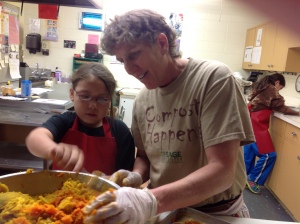
Feeding Kids in Schools
What do the kids like to eat from the garden? Do they eat winter squash?
We’re teaching them to eat winter squash, pie pumpkins process them in the kitchen have a processing day where we invite students and the cooks in, and we process the pumpkins into 16 cup bag size which the cooks need to use for their recipes.
We have a great time! The kids love learning new things. They are so empowered they know they did it with their own hand. The day we serve the pumpkin bars, the cooks tell the kids who worked in the kitchen they just beam with pride.
unbelievable the kids had
When I worked at Head Start we would do a cooking project like once every two weeks or once a month and it was such a great way to
Cucumbers is great the thing that drives me crazy that when they feed the kids carrots, or celery etc, they seem to always serve it with Ranch Dressing. The carrots I’ve seen a lot are the ones in the little plastic bags.
The pencil sharpener ones? The ones that look like your little finger?
The put preservatives on them. I try to get people to not eat them.
I thought they were just the little baby carrots. They will be in the little individual wrapped plastic bags and they can be watery sometimes, you know why the kids want ranch dressing to eat them.
If they would just list the ingredients, the very first ingredient that is made with soybean oil,
Unless you’re gonna eat a handful of soy beans, that an high fructose
If someone gave you a handful of soybeans or corn, you wouldn’t eat it in it’s raw state, why would you eat it in a product?
They are feeding it in our schools it must be good, I think there’s something to be said, they’re trying their best.
There’s a great website Maplight.org and they talk about where money comes from to influence our politicians. They use an example of putting healthy fruit in our snacks for kids and the processing lobbyists changing form fresh to nutritious food so they could include things like fruit cups. I remember the things that drove me crazy were the pineapple sticks in plastic bags too and change it to processed food instead of locally grown.
If schools get their local wellness committees working properly, those will self-adjust. We really hammered away at it by giving the students a voice. The wellness committee is the cooks, and myself, and the health/PE teacher, superintendent, local grandmother who’s a nurse, and the student body president.
When I talk to the student body president to get their opinion of what needs to change in the school, they know instantly what they want. So I took to bat to make those changes happen! They wanted real potatoes and recognizable meat, so we made it happen! For the last 2 years, we’ve had real potatoes, and when we got those they were the first real potatoes served in the school in 16 years.
Didn’t you tell us something at the conference, it’s a rule they have to have one of these committees? You can go to your school and find out if this committee is meeting, and then go from there.
Part of the Federal School lunch program. If they get school lunch, any subsidy from the USDA, it’s supposed to be functioning.
OK listeners so get out there and find out what your kids are eating in their school lunches and find out if there is a wellness committee and make sure our kids are getting the healthiest lunches they can get!
Something that you find is easy to grow and is generally successful in your climate?
Potatoes are very very successful. We get our potatoes from the Montana Potato lab, we planted 5 different varieties this year, we planted variety that are super good to eat. They want the old fashioned baker potato and the kids want something cool and bright colored! We make potatoes salad out of the ones that are cool and unusual! And grow russets for the cooks! We grow red potatoes for the mashed potatoes, wow the kids dig ’em, and deliver them to the cooks. We have little waste on those days!
What kind of colored potatoes are you growing?
They grow everything to huckleberry gold, that’s purple on the outside and yellow on the inside, and purple, purple, and blue ones and yukon gold. They get into wild stuff. Looks really cool in a potato salad!
Huckleberry gold I’m gonna have to sound those, I’m not sure about eating a potato that’s purple on the inside, or blue? I do like to buy new seeds, and crazy stuff so maybe I’ll have to try those next year.
Something you would steer new gardeners away from that you find is typically challenging to grow in your climate.
People talk about sweet potatoes but this is not sweet potatoes country so I wouldn’t attempt that. I really want people to thing about improving their soil health by, compost, letting
plant tilling radishes to improve the soil, rather then just add more fertilizer and water. If we can get the soil improve by itself, we will reduce the water usage and you won’t need to buy fertilizers which take a lot of energy to produce, so that should be the ultimate goal for everybody to improve soil through natural practices.

Which activity is your least favorite activity to do in the garden.
I really don’t have one… if someone forced me to spray pesticide that would definitely be it. We haven’t had any chemicals in the garden since it’s beginning. I call it integrated pest management, even if we have a pest to manage, we don’t manage, either we break it’s life cycle naturally. Cabbage butterfly worms, pick them off the basics family. We do all natural organic type.
With the potatoes, we put the potatoes in the compost
add straw and add more straw, and that breaks the cycle of the Colorado Potato Beetle, t
let the potatoes grow up through it,
breaks the cycle of the potato beetle
they don’t like to bore down through that.
that in itself is a great tip to make.
Do you want to tell us more about that? How big is your compost pile?
We take the compost out of
add it to low tunnels.
add compost to them, so we’re growing potatoes in pure compost, cause all we do is add compost to those tunnels,
not growing in soil. compost over compost over the last five years.
A lot of listeners have asked about the potatoes beetle.
We haven’t had a potato beetle in the garden in years. We have a big issue of potato beetles in the region so I know our tactic is working.
Another tactic is to draw the pollinators and a lot of
plant a lot of flowers.
polyculture in our gardens. … like we plant lots of different plants in one bed.
When I taught the Golden Triangle teachers in a workshop this summer for 2 days, as a mater of fact, Jennifer Hill-Hart and Aubree Roth came to that training.
26 plants in one 4×16 bed
That’s a polyculture.
Nasturtiums
Marigolds have a lot of chemicals in their makeup, that deters other pests from growing in the area they are growing and they harbor spiders, itsy bitsy little spiders…
I wanted to ask you back at the beginning why did you have that huge bed of marigolds?
Back in 1993-94, we were gonna turn them into potpourri. I got a contract to sell the blooms to my local seed salesman at the time. But it happened to be the year I was pregnant, so we didn’t get many blooms harvested between my ex, my ranch hand and myself. Every time I was out there, I was having morning sickness, and the guys were busy. So it turned into a beacon of planes coming over wondering what was growing in the prairie that was so bright. It was really pretty and we had a lot of bees.
We always grow a lot of marigolds and plant them around our vegetables and it
Teach Floriculture in the FFA
National convention to complete in Floriculutre. in Florida?
Cut some buckets of them in the shop, someone’s standing around with nothing to do, I’ll have them go gift them to someone in the community. We call it Growing a healthier community. The students
Learning about flower arranger
gift it to the banker, recognize to
flowers just grow right to the heart.
That project comes in itself is quite remarkable, it all stemming from having lots of flowers in the garden…
What are some tips for flower arranging…
We have some really big bases, grow the sunflowers to dry in the pollinators
bees can see them from the
Im pretty sure we have the majority of bees in all of the Hinsdale region, we attract them from the miles around… all they have to do is come to the school garden… they are really tall, we grow, the more we pick them the more there are for blooms, an more pollinators for insects.
We start with a tall vase. We start will a filler, use borage, it’s an edible flower tastes like a cucumber, holds up the other flowers, then stick in the tallest sunflower that we want to use that’a bout the same height as the vase in the center. Then try to be symmetrical from there, balancing from there, put one on one side, kids stand back and look and say I need some here, and then its done!
What is your favorite activity to do in the garden.
I really like taking pictures in the garden. Especially in the morning, when we start getting into August and the garden is full of flowers. We have tons of tons of bees, educational bee project going on, teaching kids about the native bees, between the flowers an the bees, my favorite picking the food and eating it.
What is the best gardening advice you have ever received?
I have a lot of people who I would consider Mentors, who are gardening gurus.
Elliot Coleman from 4 Seasons Farms in Maine, I’ve watched his videos, and watched him on TV growing up. About anything he has done would be great advice.
Another person here in our state would be Bob Quinn’s Organic Gardening mindset and visionary.
He was on episode 77, it’s a good one!
Geoffrey Lawton, permaculture guru, been a geek of his. Turning my lawn into an edible landscape and I’ve been using his tactics, plan not to have a lawn-mower, an educational site to convince people to stop mowing their lawn and start growing food.
How big is your school garden?
I know what an acre is…
For sure a city lot, about 4 city lots, the back fence in the edible school yard, if you go on the FB site you can see the edible school yard, it’s got a planting that’s about 6 foot by 30 yards, of pumpkins and straw bales and things they put along that fence.
Anyone is invited that would want to learn about gardening!
Have you ever entered a fair? How’d that go?
I’ve entered Fairs all over the place from NY – Michigan 0
Nation Champion bull in Louisville KY
Highlight lately, taking the Farm-to-School in Glasgow Fair
Took in the bee boxes, and planters that said grow food. All sorts of things the kids do in the outdoor classroom took all that stuff to town
a bee matching game…
native bees, bumble bees, mason bees, squash bees. There’s a whole world of bees nobody knows about, learn about how
bumble bees pollinate tomatoes
Please help Patti’s School by filling in the survey for the food tray
Sunflowers attract most bees, lots of different bees. Every one of those seeds is actually a floweret. They attack all different pollinating flies. All kinds of stuff come to a sunflower. They’re so cool to start bringing in the whole bio-life… good main stay.. to come to what
What other flowers do you like to plant?
For sure, the borage, and the comfrey are great for pollinators,but are also deep miners, pull all sorts of minerals into leaf system. Those leaf systems, we can compost those minerals, chop and drop on the ground anywhere we want those minerals. Do
We plant a lot of calendula, marigolds. cosmos, Belles of Ireland, all kinds of stuff we can to use for the flower arranging. This year hail wiped out anything that is fragile, which is most of our flowers.
Do you plant zinnias?
They are on the list of add to the ever growing “buy me” list.
A favorite tool that you like to use? If you had to move and could only take one tool with you what would it be.
Now that I’ve changed my gardening tactics to more layering cardboard, compost, straw, cover upper
pruning shears… We use a potato fork quite a bit, if we’re gonna transplant tomatoes. We’re not tilling, we don’t till anything.
But I’ve fallen in love with the pruning sheers this year, too. I said the tool I couldn’t live without when my friend Lisa interviewed me was my wheelbarrow. I used my shears this year a lot. I didn’t early cut any of them.
The heads that you were talking of where the little flowers go you are just holes but there weren’t many on the ground so I think the birds are getting them.
My project this year was to grow 750 seeds, I realized Im never gonna get them to the florist,
I planted all different varieties.
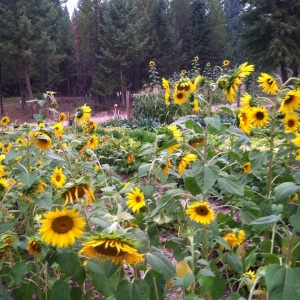
Black Oil Sunflower Seeds in Foreground, Martha Stewart Organics Tower over corn in Background
We buy a lot of those black-oil sunflower seeds, those are the ones the birds were on, some of these outside my window that have like 5 blooms on a stem is where I actually saw a bird on one the other day.
The Martha Stewart ones were the ones that I planted the earliest and definitely got to be the biggest.
A favorite recipe you like to cook from the garden?
I was doing a psychological game to get the kids to eat, it’s always a game to get them to recognize
Farm to Schools
We’re part of Aubree Roth’s, Harvest of the Month project.
I’ll use the lentil example
we need to change this culture.
We grow lentils in this area. I can ask them to do almost everything
I asked the 7th and 8th graders to sit at the tables in the cafeteria so there would be student leaders with computers. Then I told the younger students, go find an older student to sit with
Have you guys ever heard of lentils?
Who grows lentils here? 2 kids raised the hands. and they were the sports kids? So the kids were like ahhh! And John grows lentils!
Lentils are just some of the most protein, people eat them all over the world. Do you eat them here? No, So we said we made them into a little bit of hummus, and lets put them on a cracker.
So the kids are helping them fill out the surveys, so it goes fast!
73% of the kids said they like
95% said they had never heard of lentils before
65% said they’d eat lentils if they were in the salad bar once in a while.
What a way to involve technology and science and food and any parent or teacher will get you to eat the kids engaged! And getting them to eat hummus too!
A couple of products. My cooks just google it to find a recipe that will work fast and easy for them.
A favorite internet resource?
I’m a research guru. I put myself through online college, and have a biz degree now while I’ve been teaching school and FFA. So I’m just a research fanatic.
Ted Talks is my favorite of all. Usually in the food organic scene. But Elliot Coleman’s is pretty stellar and so is Geoffrey Lawton’s website.
Linda Kelso was talking about these Biophillia talks coming out of the Phipps Conservatory in Pittsburg which are kind of like Ted Talks for organic sustainable food.
A favorite reading material-book, mag, blog/website etc you can recommend?
Fredrick Kirschenmann originally from North Dakota now with the Leopold Center for Sustainable Agriculture, out of Iowa State. I started studying him about 6 years ago, he was talking about poly cultures and biodiversity of soil. He’s mostly on the video’s don’t have time to read that many books, so I usually do my research on the internet.. Well worth checking out and studying he has this whole thing figured out what agriculture’s got to be to become resilient. He’s way out there… very knowledgable!
If you have a business to you have any advice for our listeners about how to sell extra produce or get started in the industry?
My latest passion is to try to get people to realize, every person to realize there’s something more they can do to make the future better.
my latest visionary is to get every person to realize they are part of the solution or they are the problem. That’s right now the cutting edge of what I try to get people to think, I guess. If we could just think about little things, like stop drinking anything with high fructose corn syrup that would make a big impact on the world because then the need for that GMO corn would be reduced.
the practice
dollars
we need to leave a better place for the children then we are today.
You’re connecting the dots that the soda your drinking is not just affecting your health or for our planet.
Final question- if there was one change you would like to see to create a greener world what would it be? For example is there a charity or organization your passionate about or a project you would like to see put into action. What do you feel is the most crucial issue facing our planet in regards to the environment either in your local area or on a national or global scale?
If we really could get people to think, and them to recognizte they are the problem. I think the majority of the people are ignoring doing anything about it, just kind of sticking their heads in the sand, which is the majority. We need to get people thinking I can be part of the solution.
Even if it’s just that small like deciding I’m not gonna drink a soda,
if we get several we’re gonna change the world.
the majority of people don’ to anything, so if a small percentage of people take action we’re gonna get
I think that’s why you’ve made such a giant impact. Those kids are gonna go on, like I said in my email you’re gonna go on and run for Congress or become our superintendent of schools some day, you take action and made lots of difference in people’s live.
One take away if I need people to think harder, I stab em in the heart, think about your grandkids a hundred years from now, and what would they write in a letter to you… Did you do anything? You knew things weren’t going well… I just want people to do something… to be the solution.
Thank you for sharing with us today. You’ve made such a big impact. I hope listeners will take action!
Do u have an inspiration tip or quote to help motivate our listeners to reach into that dirt and start their own garden?
Just do it! Don’t listen to a single nay sayer, I hear them and I use that for fuel. And make myself go to the limit! I don’t take no for an answer. You can grow lots of food without any chemicals!
I work with the national FFA movement and their hunger mission to stop hunger in America. I just really really believe we can do something.
and you are living proof that we can do something. Just by speaking up, and that people can you have healthy food in your school and promoting local farmers.
Always leave people with people are always eager to hear more from me, when I wrap up a session. And they’ll say Well we can’t possible grow enough food with organic practices to feed the population. I just leave them with something to think about. They don’t have to worry about the food, they have to worry about the water. We’re gonna run out of water way before we run out of food. I truly believe that growing food in a sustainable way, is gonna conserve the water… food that is coming out of rich organic soil then what’s coming out of production ag at the moment. It usually leaves them jaw-dropped because it’s true!
What’s important to a human, food, water, shelter, and clean air…
and you’re teaching people how to have all those here and it’s so important. And I love your action steps that we talked about today like just putting borage and comfrey in your garden for the bees and pollinators.
How do we connect with you?
Hinsdale Outdoor Classroom Facebook site or the Hinsdale FFA site. They can see the Root cellar is on FFA site. You can walk through process on how to do it on your own. The outdoor solar greenhouse is on the Hinsdale Outdoor Classroom site!
I’m supposed to be the Keynote Speaker at the Growing Youth Summit in Livingston and Rocky Boy. Hopefully we can get some adults and kids to come to that. It’s the Farm to School leadership. Coming up in Billings – Oct 5th Livingston is Oct 11th which I’m speaking at. And Rocky Boy is October 24th, and Kalispell on Oct 26th – teaching kids how to grow local food.
Farm to School
Down the road I may end up consulting and still teach school. we’re on a 4 day school week…I love helping other people. Right now you have to get to me through the FB School Sites.
Practical strategies for future food and agriculture challenges
https://www.youtube.com/watch?v=dXZWJyENLQc
OGP is dedicated to encouraging gardeners and people who want to grow food and flowers to choose an organic approach
The Organic Gardener Podcast is a participant in the Amazon Services LLC Associates Program, an affiliate advertising program designed to provide a means for sites to earn advertising fees by advertising and linking to amazon.com
Also if you know anyone from any of these states I am always looking for guests!
- Alabama
- Alaska
- Arkansas
- Connecticut
- Delaware
- Iowa
- Kansas
- Louisiana
- Maryland
- Mississippi
- Missouri
- Nebraska
- Nevada
- New Hampshire
- New Mexico
- North Carolina
- North Dakota
- Oklahoma
- Rhode Island
- South Carolina
- West Virginia
To learn more please visit our website at the organicgardenerpodcast.com
and remember we’d love if you’d join Organic Gardener Podcast Facebook Community!
If you like what you heard on the Organic Gardener Podcast we’d love it if you’d give us review and hopefully a 5 star rating on iTunes so other gardeners can find us and listen to. Just click on the link here.
If you like what you heard on the Organic Gardener Podcast we’d love it if you’d give us review and hopefully a 5 star rating on iTunes so other gardeners can find us and listen to. Just click on the link here




